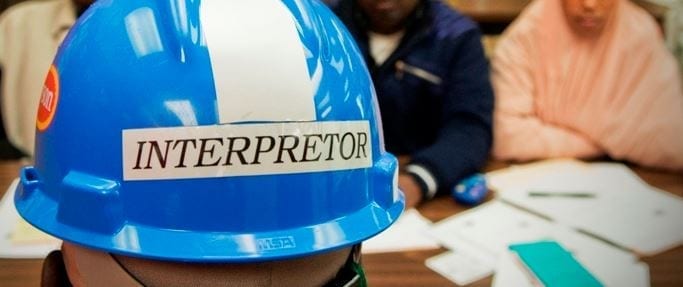
Working with Interpreters
Identifying victims, interviewing
recovery all often require the assistance of an interpreter. Interpretation is an art as much as it is a science. It is wrought with cultural and political pitfalls for even the most skilled translators. Even when the resources exist to work with well-trained and highly experienced interpreters, bringing an intermediary party into an already complex dynamic can be an added challenge.
Interpreters often come from the same national, political and cultural context as the survivors for whom they are translating. This can be an enormous advantage: interpreters can offer cultural guidance as well as linguistic translation. However, it can also be a disadvantage. Often, trafficking survivors has been victimized by others from their country or by those from a different ethnic group. Therefore, they may be particularly wary of trusting someone from a group that has hurt them in the past. Consider this hypothetical case study:
Aung, an exiled activist from Burma, has lived in Australia for 14
years and makes his living as an interpreter. One day, he is asked by thepolice to interpret an interview withLawbeh , a woman who has fled fighting in Karen State in Burma. Although Aung put his own life in danger in Burma by challenging the Burmese government, he can tell immediately thatLawbeh does not trust him.
can speak Burmese because she was punished in school if Lawbeh she Karen. Burmese-speaking soldiers terrorized her village and raped her sister. Burmese-speaking traffickers tricked her into an Australian brothel where she serviced up to 40 men a day. Lawbeh does not know who Aung is. He could be an informant for the military junta. He could be the cousin of her trafficker. She keeps her eyes on the table, speaks softly and offers little information. spoke
— Adapted from Assisting Survivors of Human Trafficking
When her history is understood, it is not surprising that
disclose. However, if the police officer is not familiar with her home context, it may be difficult for him to understand Lawbeh’s reticence:
The Australian police officer prides himself on his cultural competence.
He has worked with countless trafficking victims. He is good atbuilding rapport . He understands thatLawbeh is probably showing respect for his authority through her lowered eyes, as many people from Asia do. He is patient and persistent and when Aung says, “Lawbeh is notso comfortable in Burmese,” he is careful to speak slowly in English and use very simple words and sentence structures. But the interviewgoes nowhere .
The police officer misinterprets Lawbeh’s non-verbal signals; assuming that she is not making eye contact and speaking softly because that is what Asians do to show respect. Perhaps he has learned this in past workshops, but his rudimentary understanding of what could be a cultural pattern has become fixed as a stereotype and interferes with his ability to read the situation in a more nuanced way.
Communication patterns vary dramatically from culture to culture, and this police officer may be expecting a more direct and explicit language, while in Burma and many other countries, communication about negative things, especially, tends to be careful and cloaked in smiles, metaphor or non-verbal signals so as not to cause offense. And so he misses the subtle implication that
Service providers and law enforcement can use a translator as a cultural and political interpreter as well. It can be useful to have a side conversation, outside of the presence of the client to ask the interpreter questions such as: What is going on? What might Lawbeh be feeling? How are YOU feeling about this case? What might we be able to do together to change the dynamic? A series of questions such as these are likely to yield more nuanced information than simply accepting the first explanation (discomfort with Burmese) at face value.
But limited resources dictate our options. Even if it is understood that Aung is not the best interpreter
Gender dynamics can sometimes be accentuated if the interpreter comes from the same culture.
Translation rarely happens in a vacuum. It is contextualized. If they come from the same part of the world, we cannot assume that a survivor will feel at home and at ease with an interpreter. Someone from the same neighborhood might be less welcome than a complete outsider – or vice versa. Trafficking survivors have complex, whole histories – like all of us. The best we can do is listen deeply, watch carefully, ask open questions, and stay humble.
SOME UNCOMMON TIPS FOR WORKING WITH INTERPRETERS
BEFORE THE INTERVIEW….
- Don’t assume similarity or affinity between the survivor and interpreter
- Ensure that interpreters translate one sentence or phrase at a time
- Have a preliminary meeting with the interpreter without the client present to screen for possible ethnic/political/gender dynamics
- Don’t assume the survivor understands the interpreter or vice versa. Sometimes a survivor’s first language is not the dominant language in their home country
DURING THE INTERVIEW… - Always talk to the survivor (not the interpreter)
- Look at the survivor when you are listening — even when the interpreter is talking
Laura Shipler Chico MSW is a freelance writer and author of Assisting
Survivors of Human Trafficking: Multicultural Case Studies. She lives in
London.
Sources:
Chico, Laura Shipler (2009) Assisting Survivors of Human Trafficking:
Multicultural Case Studies. Washington, DC: National MultiCultural Institute https://humantraffickingsearch.org/resource/assisting-survivors-of-human-trafficking-multicultural-case-studies/
Joyce, Cynthia, International Ombudsmen Association, “The Impact of Direct and Indirect Communication,” https://www.ombudsassociation.org/Resources/IOA-Publications/The-Independent-Voice/November-2012/The-Impact-of-Direct-and-Indirect-Communication.aspx
Shafer, Sarah and Jacqueline Evans (2018) Interpreters in Law Enforcement
Contexts: Practices and Experiences According to Investigators
https://onlinelibrary.wiley.com/doi/full/10.1002/acp.3388
Tribe, Rachel and Jean Morrissey (2004) Intervention, Good Practice Issues in Working with Interpreters in Mental Health,
http://ourmediaourselves.com/archives/22pdf/129_142%20Tribe.pdf
